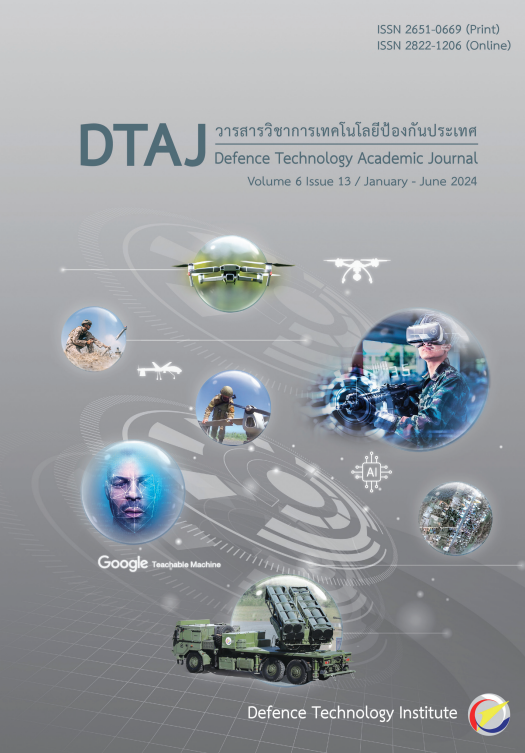Applying Google's Teachable Machine to Detect the Faces of Criminals according to Arrest Warrants
Main Article Content
Abstract
This research focuses on studying and evaluating the feasibility of using artificial intelligence (AI), specifically Google’s Teachable Machine, for detecting faces of criminals in the border areas of three southern provinces. The researchers conducted a study and research process involving the examination of three hyperparameters of Google’s Teachable Machine: 1) Epochs, 2) Batch size, and 3) Learning rate. Data preparation and system testing were carried out by inputting facial data of terrorist and non- terrorist to allow the AI to learn and differentiate between the two, a process known as machine learning. The researchers sought appropriate hyperparameter values through study and iterative experimentation to achieve the clearest and least biased face detection possible. The research findings revealed that the suitable hyperparameter values were Epochs = 100, Batch size = 256, and Learning rate = 0.001. Subsequent testing demonstrated that Google’s Teachable Machine achieved a face detection accuracy of 96.50%. This study illustrates that Google’s Teachable Machine is effective in face detection and serves as a valuable tool, saving time and reducing programming complexities. Individuals interested in further exploration can utilize Google’s Teachable Machine or AI to obtain more accurate and efficient results.
Downloads
Article Details

This work is licensed under a Creative Commons Attribution-NonCommercial-NoDerivatives 4.0 International License.
Journal of TCI is licensed under a Creative Commons Attribution-NonCommercial-NoDerivatives 4.0 International (CC BY-NC-ND 4.0) licence, unless otherwise stated. Please read our Policies page for more information...
References
Institute for Economics & Peace. “2022 Global Terrorism Index.” VISIONOFHUMANITY.org. https://www.visionofhumanity.org/maps/ global-terrorism-index/#/ (accessed Jan. 29, 2024).
Institute for Economics & Peace. “Vision of Humanity.” VISIONOFHUMANITY.org. https:// www.visionofhumanity.org/maps/global terrorism-index/#/ (accessed Jan. 29, 2024).
ก. สระอุบล, เรียนรู้ Data Science และ AI: Machine Learning ด้วย Python. กรุงเทพฯ, ไทย: มีเดีย เนทเวิร์ค, 2563.
จ. น้อยมณี, AI Government Framework กรอบการทำ งานปัญญาประดิษฐ์ภาครัฐ. กรุงเทพฯ, ไทย: บริษัท พีเอเอ็น (ไทยแลนด์) จำกัด, 2563.
H. Jeong, “Feasibility Study of Google's Teachable Machine in Diagnosis of Tooth Marked Tongue,” J. Dent. Hyg. Sci., vol. 20, no. 4, pp. 206-212, 2020.
S. Nupap and O. - U. Pramote, “Design and Development of Character Recognition Applications on Mobile Devices for Practice Writing Thai Consonants,” in The 13th NPRU Nat. Acad. Conf. Nakhon Pathom Rajabhat Univ., Nakhon Pathom, Thailand, Jul. 2021, pp. 641-649. (in Thai)
J. Sanuksan and O. Surinta, “Deep Convolutional Neural Networks for Plant Recognition in the Natural Environment,” J. Sci. Technol. MSU, vol. 38, no. 2, pp. 113-124, 2019. (in Thai)
J. T. Roscoe, Fundamental Research Statistics for the Behavioral Sciences. NY, USA: Holt Rinehart and Winston, 1975.
ส. เกษจำรัส. “AI คืออะไร? ทำความเข้าใจ AI แบบง่าย ๆ.” BEARTAI.com. https://www. beartai.com/article/tech-article/424875 (วันที่เข้าถึง ม.ค. 29, 2566).
บ. ศรีสะอาด, หลักการวิจัยเบื้องต้น, พิมพ์ ครั้งที่ 3, กรุงเทพฯ, ไทย: สุวีริยาสาสน์, 2535.
Generated Media. “Generated faces.” GENERATED.PHOTOS. https://generated. photos/faces (accessed Jan. 30, 2024).


